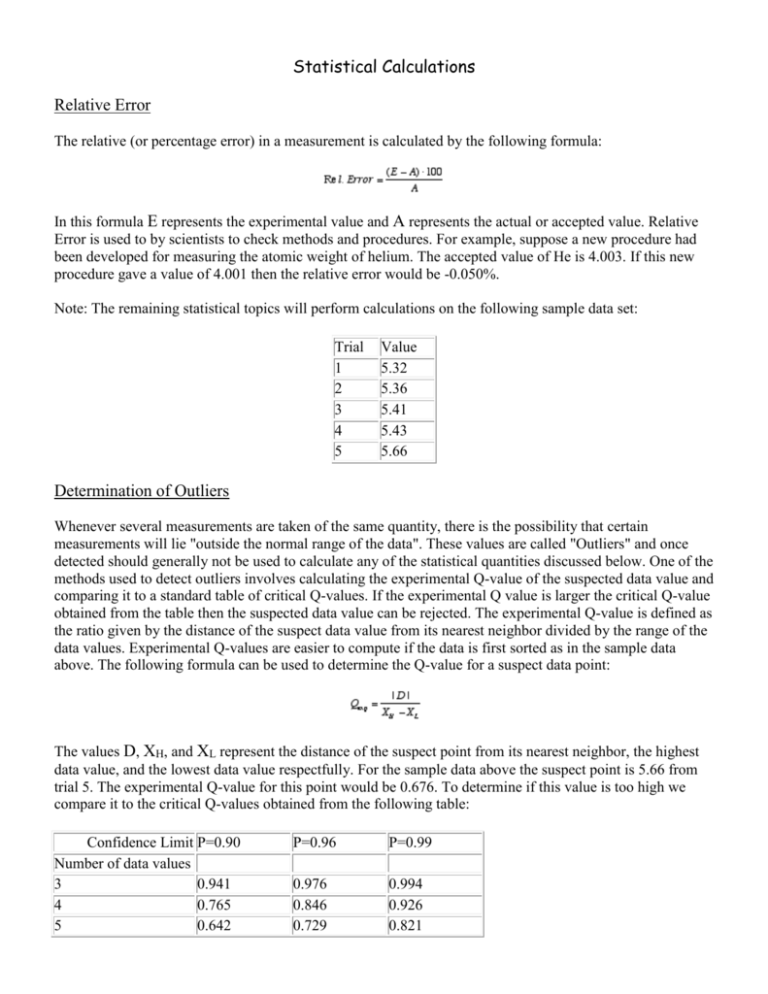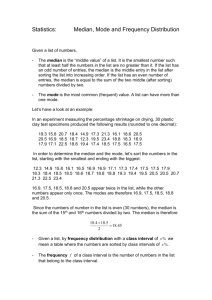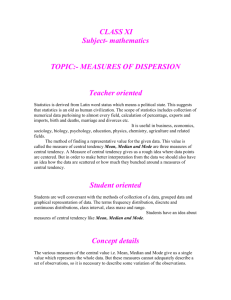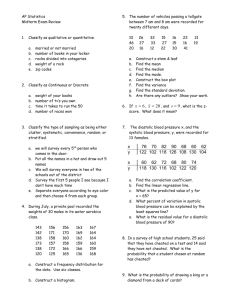Statistical Calculations
advertisement

Statistical Calculations Relative Error The relative (or percentage error) in a measurement is calculated by the following formula: In this formula E represents the experimental value and A represents the actual or accepted value. Relative Error is used to by scientists to check methods and procedures. For example, suppose a new procedure had been developed for measuring the atomic weight of helium. The accepted value of He is 4.003. If this new procedure gave a value of 4.001 then the relative error would be -0.050%. Note: The remaining statistical topics will perform calculations on the following sample data set: Trial 1 2 3 4 5 Value 5.32 5.36 5.41 5.43 5.66 Determination of Outliers Whenever several measurements are taken of the same quantity, there is the possibility that certain measurements will lie "outside the normal range of the data". These values are called "Outliers" and once detected should generally not be used to calculate any of the statistical quantities discussed below. One of the methods used to detect outliers involves calculating the experimental Q-value of the suspected data value and comparing it to a standard table of critical Q-values. If the experimental Q value is larger the critical Q-value obtained from the table then the suspected data value can be rejected. The experimental Q-value is defined as the ratio given by the distance of the suspect data value from its nearest neighbor divided by the range of the data values. Experimental Q-values are easier to compute if the data is first sorted as in the sample data above. The following formula can be used to determine the Q-value for a suspect data point: The values D, XH, and XL represent the distance of the suspect point from its nearest neighbor, the highest data value, and the lowest data value respectfully. For the sample data above the suspect point is 5.66 from trial 5. The experimental Q-value for this point would be 0.676. To determine if this value is too high we compare it to the critical Q-values obtained from the following table: Confidence Limit P=0.90 Number of data values 3 0.941 4 0.765 5 0.642 P=0.96 P=0.99 0.976 0.846 0.729 0.994 0.926 0.821 6 7 8 9 10 11 12 13 14 15 16 17 18 19 20 21 22 23 24 25 26 27 28 29 30 0.560 0.507 0.468 0.437 0.412 0.542 0.522 0.503 0.488 0.475 0.463 0.452 0.442 0.433 0.425 0.418 0.411 0.404 0.399 0.393 0.388 0.384 0.380 0.376 0.372 0.644 0.586 0.543 0.510 0.483 0.460 0.441 0.425 0.411 0.399 0.388 0.379 0.370 0.363 0.356 0.350 0.344 0.338 0.333 0.329 0.324 0.320 0.316 0.312 0.309 0.740 0.680 0.634 0.598 0.568 0.392 0.376 0.361 0.349 0.338 0.329 0.320 0.313 0.306 0.300 0.295 0.290 0.285 0.281 0.277 0.273 0.269 0.266 0.263 0.260 For a confidence limit of 90% (P=0.90) trial 5 can be rejected since its experimental Q-value (0.676) is larger than the critical Q-value for 5 trials (0.642). However, the value could not be rejected if one desired a higher confidence limit since the experimental Q-value is less than the corresponding critical Q-value at the higher confidence limits. Note: The following statistical calculations are going to be done at a confidence limit of 90% (P=0.90) and since trial 5 has been determined to be an "outlier" at this confidence limit it will be rejected from those statistical calculations. Mean or Average The mean of a set of values, which is denoted by the symbol x, is calculated by the following formula: In this formula n represents the number of data points, and xi represents a specific data value. Applying this formula to the sample data above one obtains a mean of 5.380. (If trial 5 is not rejected the mean would be 5.436.) Median The median value of a series of measurements is the middle value. In order to find the median of a set of values the measurements must be sorted as the sample data above is. The median of the sample data is the value of trial 3 if trial 5 is not being rejected, that is, 5.41. If the median is being determined for an even number of trials the average of the two middle values can be taken. Since we are rejecting trial 5 the median would be the average of trials 2 and 3 which is 5.39. Standard Deviation The standard deviation, sometimes abbreviated with the Greek symbol sigma (s), gives an indication of how well the data is grouped around the mean value. A large standard deviation indicates that several values were significantly above and below the mean indicating low precision data, while a small standard deviation indicates that the values were quite close to the mean indicating high precision data. For example, both plots below show the results of two procedures, both of which attempted to measure the atomic weight of Ne. Both plots have a mean of 10, however, the data from procedure 1 is of higher precision because the standard deviation is only 1.61 vs. 2.45 for procedure 2. The formula for calculating the standard deviation is given below: When this formula is applied to the above sample data a standard deviation of 0.050 is obtained to a confidence limit of 90%. This means that 68% of the values lie within ±0.050 units of the mean or within the range of 5.330 to 5.430 (5.380 ± 0.050) for the above sample data. Plus or minus two standard deviations (5.380 ± 0.100) of the mean encloses about 98% of all data points. Average Deviation The average deviation is easier to compute but less often used than the standard deviation. It is computed by the following formula: In terms of the error curve the probability that another measurement lies within ±a of the mean is 57%. For the sample data given above the average deviation would be 0.04. This means that the probability of the next measurement falling in the range of 5.34 to 5.42 (5.38 ±0.04) would be 57%.










